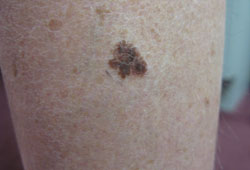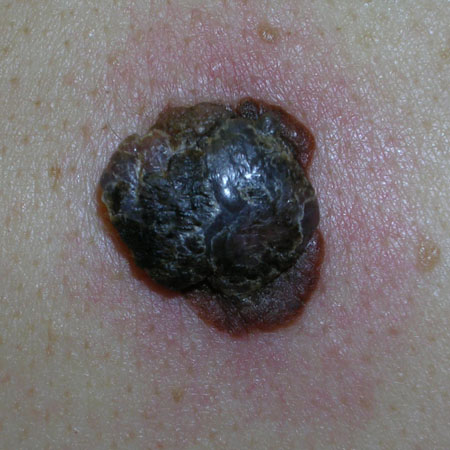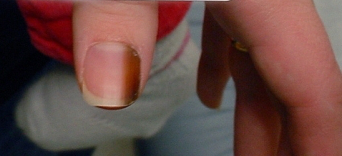Etiology
Melanoma arises from melanocytes, the pigment-producing cells found in the skin, eye, and central nervous system. Etiology relates to both environmental and genetic factors. Genetic factors include the inheritance of sun-sensitive skin (Fitzpatrick skin type I and II, red hair, blue eyes, and susceptibility to sunburn) and specific melanoma-related genes.[14]
Environmental factors include excessive exposure to solar and artificial ultraviolet radiation (e.g., tanning beds) and proximity to the equator.[14][15][16] History of sunburn and intermittent high-intensity sun exposure are more strongly associated with melanoma development than cumulative chronic sun exposure.[17]
The major susceptibility gene associated with familial melanoma is CDKN2A, which encodes the P16 and p14ARF proteins. These proteins affect the p53 and retinoblastoma (Rb) cell cycle genes.[18] DNA repair defects (as in xeroderma pigmentosum) are also implicated.
It is estimated that less than half of melanomas arise in pre-existing nevi; however, reported rates differ considerably (25% to 42%).[19][20][21] Nevus-associated melanomas are associated with younger age at presentation.[22]
Pathophysiology
The pathogenesis is varied and is the subject of ongoing research.
In cases that arise from a precursor nevus, p53 expression is increased and Bcl-2 and p16 expression is decreased, compared with benign control pigmented nevi, suggesting that alterations in expression and localization of cell cycle regulators might contribute to tumorigenesis.[23]
Cellular pathways with a high frequency of mutations include the RAS mitogen-activated protein kinase (MAPK) pathway, which activates the BRAF and NRAS oncogenes, and the CDKN2/RB1 pathway.[24] BRAF mutations are present in approximately 40% to 50% of melanomas.[25][26] Valine to glutamate (V600E) is the most common mutation, accounting for 75% to 90% of all BRAF mutations, but V600K (valine to lysine) and V600D/R (valine to aspartic acid/arginine) are also present.[26] NRAS mutations are present in approximately 20% of melanomas.[25][27] BRAF and NRAS mutations are most common in superficial spreading and nodular melanomas; the BRAF mutation rate is inversely proportional to patient age.[28]
In addition to BRAF and NRAS mutations, KIT mutations are commonly found in mucosal and acral lentiginous melanomas.[29] These and other mutations, which may be inherited or induced by ultraviolet light, directly lead to impairment of the normal cell cycle checkpoints.[30][31] Unregulated growth of the tumor cells ensues, which is clinically observed as an irregular or changing skin lesion.[31]
Melanoma may grow by radial or vertical growth; however, vertical growth is more likely to result in involvement of the vasculature and/or lymphatics, leading to metastasis.[32]
Classification
Clinical classification[2]
Superficial spreading melanoma: [Figure caption and citation for the preceding image starts]: Superficial spreading melanomaFrom the personal collection of Dr Hobart Walling and Dr Brian Swick. [Citation ends].
Relatively long phase of superficial extension before penetrating deeper into the dermis
Any site, but preference for torso in men or legs in women[4][5]
Incidence increases with age, peaking at 70 to 79 years.[5]
Nodular melanoma: [Figure caption and citation for the preceding image starts]: Nodular melanomaFrom the personal collection of Dr Hobart Walling and Dr Brian Swick. [Citation ends].
Any site
Most frequently diagnosed in the fifth or sixth decade of life
Minimal superficial growth before rapid vertical growth
Usually later stage at diagnosis and carries a poorer prognosis.
Lentigo maligna melanoma:
Frequency 5% to 15%[3]
Most commonly diagnosed in older people (>60 years of age) on sun-damaged (actinic damaged) skin, particularly the head and neck
Tendency toward slow growth.
Acral lentiginous melanoma:
Accounts for a high proportion of malignant melanoma diagnosed in people with Fitzpatrick type V or VI skin
Arises on the palms, soles, and nail apparatus [Figure caption and citation for the preceding image starts]: Subungual melanoma in situFrom the personal collection of Dr Hobart Walling and Dr Brian Swick. [Citation ends].

Commonly diagnosed at advanced stage.
Rare variants:
Include amelanotic melanoma, spitzoid melanoma, desmoplastic melanoma, malignant blue nevus, ocular melanoma, and mucosal melanoma.
Use of this content is subject to our disclaimer